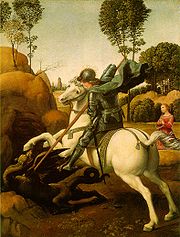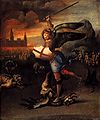Saint George
| Saint George of Lydda | |
|---|---|
"St. George fighting the Dragon" by Raphael (1505) | |
| Martyr and Victory Bringer | |
| Born | Born::275 AD, Lydda, Judaea, Roman Empire |
| Died | Died::April 23, 303 AD, Nicomedia, Bithynia, Roman Empire |
| Venerated in | Roman Catholicism Eastern Orthodoxy Oriental Orthodoxy Anglicanism Lutheranism |
| Major shrine | St. George's Church, Lod, Israel |
| Feast | April 23 (Roman Catholic) November 3 (Russian Orthodox) May 5-May 6 (Palestine) Fouth Sundy in June (Malta) Third Sunday in July (Gozo) November 23 (Georgia) |
| Attributes | Lance, Dragon, Horseback Rider, Knighthood, Military, St. George's Cross. |
| Patronage | Aragon, Bulgaria, Catalonia, England, Ethiopia, Georgia, Greece, Lithuania, Malta, Palestine, Portugal and Russia. |
Saint George (Latin: Georgius; Greek: Γεώργιος, Geōrgios; "Name means::worker of the land") (Born::275 AD–Died::April 23, 303 AD) was a Roman soldier in the Guard of Diocletian who, following his torture and execution for having renounced the Emperor's edict against Christians serving in the Roman Army and declaring his worship of Jesus Christ, became venerated as a Christian martyr.
Biography
Dragon Slaying
Saint George is best known for slaying a dragon. The tale of St. George and the Dragon was included in Jacobus de Voragine's Legenda Aurea (or Golden Legend), a collection of Saints' lives compiled around the year 1260 and translated into English and published by William Caxton in 1483.
Cathedrals have been built in recognition of and named after St. George in Ontario, Canada (1828), Perth, Australia (1888), and London, England (1848). There are also several in the United States. These cathedrals all proudly display a painting or relic somewhere depicting the slaying of the dragon by St. George.
A modern version of the legend says:
| “ | At the town of Silene, in Libya, there was a dragon, who was appeased by being fed two sheep a day; when these failed, the townsfolk offered by lot one of their young people. One day the lot fell on the King's daughter, who was led out to the sacrifice, dressed in her wedding gown. George appeared and transfixed the dragon with his spear and then using the Princess's girdle led the bemused dragon into the town, where it was beheaded. — Catholic Encyclopaedia | ” |
Gallery
References
External Links
| |||||||||||||||||




